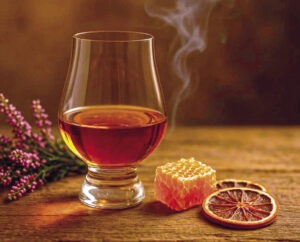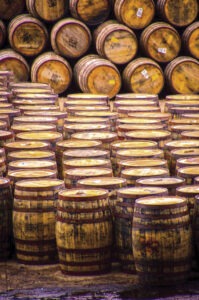(HU) Újítók a kapu előtt
Whiskeys, go home!
The beginning of 2025 proved to be a real rollercoaster ride on the international alcohol market, especially in the whiskey trade.

US president Donald Trump’s new trade policy, called Liberation Day, fundamentally changed the rules in April: a 10% general tariff was imposed on all imported products and some countries were even subject to a 50% “reciprocal” tariff. However, several bilateral agreements were reached over the summer, which gradually mitigated the effects.
A new whiskey language
Memphis-based Blue Note has created an unusual, honey-flavoured Honey Cask Bourbon. The three-year-old whiskey is “finished” in American oak barrels that were first used to age bourbon and then honey, before being reused to give the drink a rich sweetness.

According to regulations, whiskey can only be flavoured – except for the barrel flavour – after distillation and aging, i.e., before bottling. The “flavoured whiskey” category is based on traditional whiskey, to which natural extracts, syrups or aromas are added, with the goal of attracting a younger audience.
Product development based on traditional values
Age-statement whiskeys have become one of the fastest growing categories in the premium segment.

Age-statement claims are back in the spotlight
Longer maturation, respect for tradition and a demand for quality have brought age-statement products back into focus, as they represent a guarantee of authenticity and value for consumers. Both major brands and independent distillers recognise that well-communicated age statements appeal not only to collectors, but also to more conscious, quality-seeking consumers. At the same time, the category is sensitive to economic and logistics challenges. The driving force behind premiumisation remains unbroken: consumers are willing to pay more for rarer, more refined items that have a story, expertise and time behind them.
Freedom!
The world of whiskey has always been organised around styles linked to specific regions: Islay, Speyside and Tennessee aren’t just geographical indicators, but symbols of distinct flavours and traditions. Does regionality still define the world of whiskey as it used to?

For a long time whiskey meant loyalty to tradition, but today younger whiskey nations are giving new meaning to freedom. In countries such as Finland, Australia, Taiwan and South Africa distillers are free to experiment with rye, corn, alder or even wine barrels. Technology has also become part of this freedom: with modern distillation equipment, sensors and data analysis systems, even small distilleries can now achieve the product quality of large ones. So the world of whiskey is slowly breaking free from geographical boundaries.
Related news
From hair roots to hair volume
🎧 Hallgasd a cikket: Lejátszás Szünet Folytatás Leállítás Nyelv: Auto…
Read more >Price isn’t enough, promotions and re(in)novation are lifting the plane
🎧 Hallgasd a cikket: Lejátszás Szünet Folytatás Leállítás Nyelv: Auto…
Read more >The taste of luxury
🎧 Hallgasd a cikket: Lejátszás Szünet Folytatás Leállítás Nyelv: Auto…
Read more >Related news
How do young adults celebrate?
🎧 Hallgasd a cikket: Lejátszás Szünet Folytatás Leállítás Nyelv: Auto…
Read more >Vajda-Papír celebrates Ooops!’s 15th anniversary with a hybrid AI campaign
🎧 Hallgasd a cikket: Lejátszás Szünet Folytatás Leállítás Nyelv: Auto…
Read more >Pre-holiday shopping at up to half price
🎧 Hallgasd a cikket: Lejátszás Szünet Folytatás Leállítás Nyelv: Auto…
Read more >






